I sold an online course to two people for ₦90,000 each, after hosting webinars on Google meet. This happened after three months of trying to understand the people who are most likely to buy online courses, where to find them and what to say to them.
Lucky!
I needed this luck to keep on giving and never run out, so I repeated everything I did, exactly how I did it, in hopes that I would get the exact same results, maybe more. The only difference this time was that I was going to sell a different online course and ask for more money: ₦100,000. It worked, 5 people paid. From this point on, for every Google Meet webinar I hosted, between 2 and 7 people would pay for the online courses I sold, with prices ranging from ₦100,000 to ₦250,000. From that point on, all I needed to do was to scale the process.
But you’re probably wondering:
- What did she do to get these results?
- How long did it take?
- How much did she spend?
- Will I get the same results if I do everything she did?
How I increased sales using webinars
Before a sale can happen, 3 conditions need to be met:
- People need to know that what you’re selling exists;
- They need to know what it can do and how to get it; and
- They must be willing and able to pay for it.
Back in December 2021, I went back into paid employment, with, let’s call them Company X, where I led their marketing and sales department for 11 months. The first thing I did was find out what they had done and try to understand the logic behind it. According to the sales team, they had tested every marketing and sales trick in the book to sell their online courses. They told family and friends, published content on social media, ran paid ad campaigns and partnered with subject matter experts to host webinars, where they shared more information about what they do but nothing stuck, or so they thought.
I later discovered that from one of the Facebook ad campaigns they ran, 54 people registered but only 10 attended the webinar. Because 7 of these attendees were staff, I record it as only 2 attendees. NO ONE PAID, so they wrote it off as a FAILED campaign.
As someone who has spent 10 years building and testing sales funnels using webinars, this is what I saw.
- 54 people were interested.
- 2 of those wanted to learn more and so, they showed up.
For a company with a one-man marketing and sales team, still trying out stuff, this was P-R-O-G-R-E-S-S in my books!
Even though they did not realise it, the webinars made more people aware of their services. People knew they existed but no one was ready to buy anything yet. So what did I do?
The Sales Machine
Draw a rough sketch of Company X‘s roadmap to getting sales.
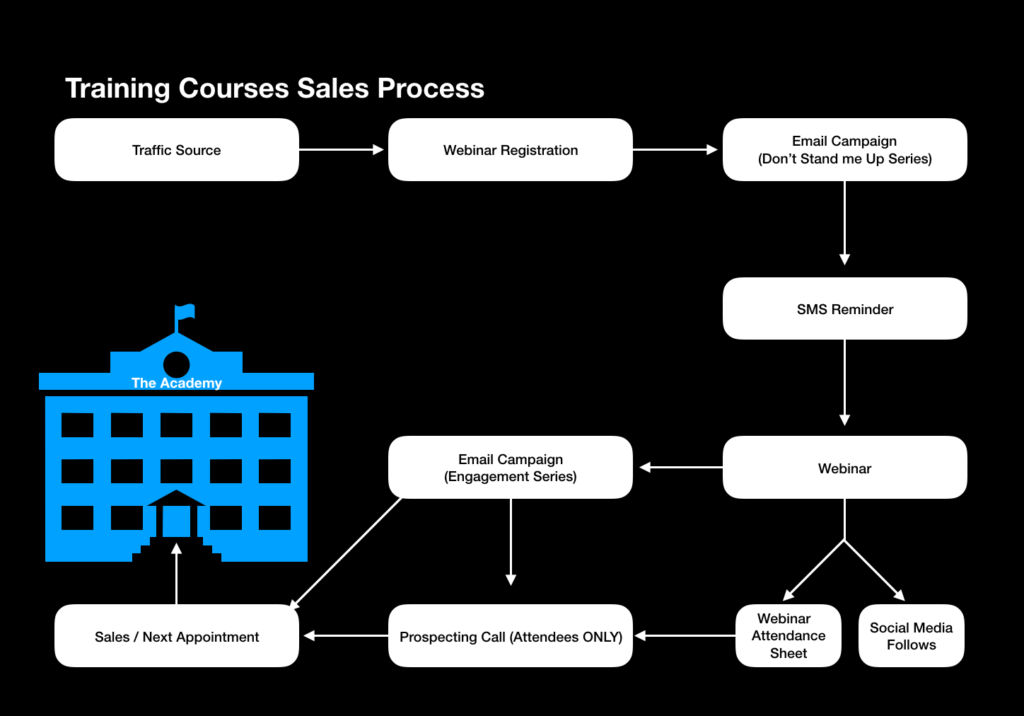
Why a sales roadmap? Because a sales roadmap is a visual representation of a company’s path to sales. It shows the plan and activities needed to achieve the desired results, sales.
For Company X the path to sales was simple:
- Identify places where people most likely to buy online courses go to.
- Advertise webinars on the online courses, at these places.
- Get people to register for the webinars, which we called free introductory classes .
- Sell online courses during these webinars.
But the thing about roadmaps is that they are always perfect on paper. Let’s test how well it worked.
The Traffic Source
The goal of the first activity on Company X’s roadmap was to get people to know they exist. A good place to start would be any location where a large number of people gather. These places (whether physical or virtual) are called Traffic sources.
With traffic sources, getting people to know you exist is simple; anyone can buy traffic. It is almost impossible to go wrong. With every traffic source I tested, Whatsapp TVs, Facebook, Instagram and Twitter, the number of registrations were off the charts, but showing up for the actual webinar, was another story.
The real question to address would be, were they the right type of traffic?
Did they have interest in purchasing online courses?
Who are the people most likely to purchase online courses?
These are the questions I needed to answer. From January to July, I kept testing several traffic sources. My first breakthrough was a sponsored ad with a Twitter Influencer who talks about CV writings and posts job vacancies. Who would have thought?
Tracking the quality of traffic can be tricky but let’s first dive into how I tackled getting them to show up and attend the actual webinar.
Pre Webinar Email Campaign
A lesson I took away from the first campaign is this: the number of people who register to attend a webinar will always be more than the number of people who actually show up to attend. Webinar registrations were up but how do I get the attendance and participation number too?
In tackling this, think about the last time you attended a Nigerian wedding. The thought of going to support a friend gets you excited. The thought of what you’re going to wear, who you’ll meet, the food you’ll eat and the gifts you’ll get (still shocked that no one talks about the fact that Nigerian weddings double as a place to get household freebies) would build up anyone’s expectation. All I had to do was infuse the logic into my sales process.
So I wrote a 5 part email series that outlined:
- The purpose, agenda and guidelines of the webinar;
- The date, time, access link and duration;
- Who the tutor was and topics to be discussed; and
- The gift to be shared at the end of the webinar.
The email series told them what to expect, where and when to expect it. This series doubled as a reminder why they registered for the webinar in the first place.
Below is a screenshot of the first 3 emails in the series.
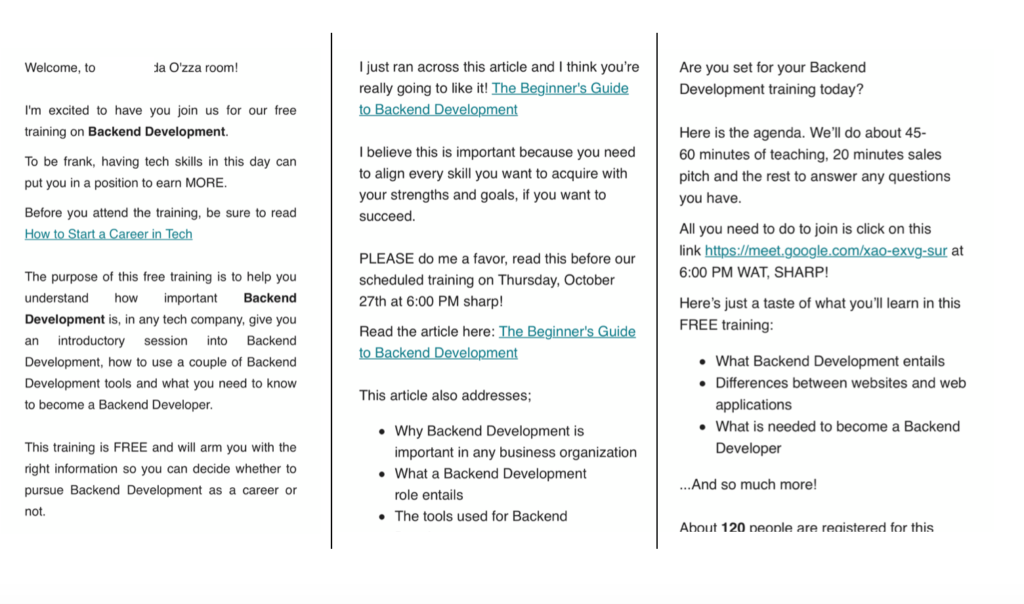
Did it work?
Here is a comparison table of the results achieved before I started adding a pre-webinar emails campaign to the sales process and the last pre-webinar email I sent before I resigned.

The Sales Pitch
Now that I know who to talk to and how to gather a number of them in one place, how do I sell to them?
The logic behind hosting these webinars was simple. Give people who are interested in specific online courses a taste of what they will be getting and then show them what they stand to gain when they pay and enrol for the actual course. For example, Company X had a Product Management online course for sale. To get people to buy it, they’ll host a free Product Management webinar, where attendees were taught:
- The importance of product management to any organisation;
- The duties and responsibilities of a product manager; and
- The skills and tools needed to build a successful product management career.
But the plan didn’t quite work the way they wanted because NO ONE bought anything.
The theory I had was this, no one bought anything because they could not connect the dots. Was paying to enrol for a Product Management course the next step to take or not?
- They didn’t know what to expect if they enrolled for the course.
- They didn’t know how many days or months it would take to complete the training.
- They didn’t even know what skills or knowledge they would acquire at the end of the training.
To fix this, I included a 30 minute presentation that would explain all this in a clear and simple way. From this simple tweak, I started getting questions like, how much is it, can I pay in instalments, what discount can you give those of us still in school and isn’t it too expensive? Finally someone was asking the right questions. I had them where I wanted but still no sale…at least not immediately.
The Payment Inquiry Form
After every webinar, my predecessor would usually call anyone who registered for the webinar, whether they attended or not. The sales pitch had done the job of identifying people who asked questions about payment. If I focused on them, perhaps I would make a sale.
So I introduced the payment inquiry form, as seen below, which I asked them fill at the end of every webinar.

The Sales Call
This script was what was responsible for the first 7 (the 2 and 5 sales I spoke about earlier) sales made while developing this sales process. With every breakthrough, I became bold. I set a goal to have a sales process with little or no human interaction involved. This is when I took a deep dive into what type of message I had in my post-webinar series.
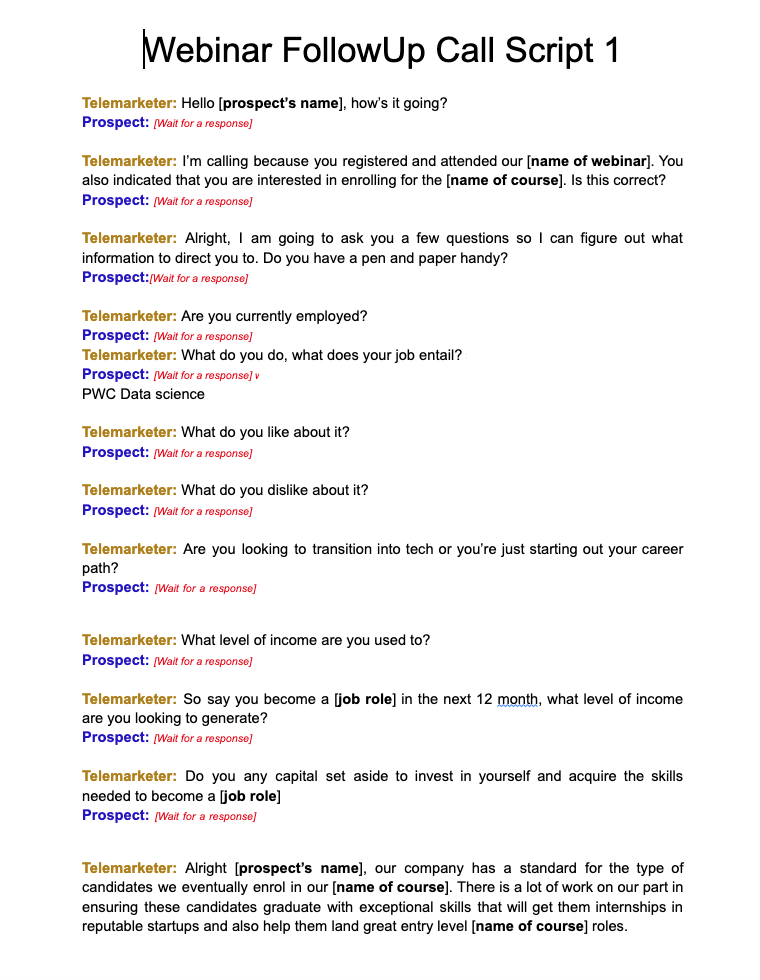
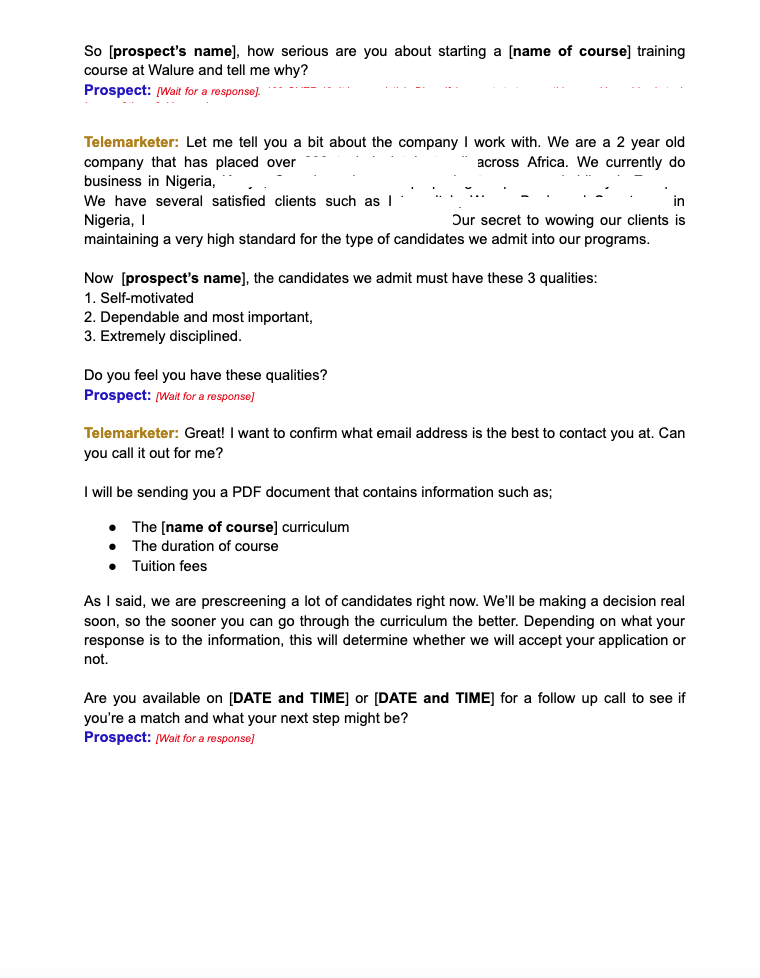
The Post Webinar Email Series
The 6 part post webinar email series was to span a period of 4 weeks. The first 3 email, all webinar attendees got within the first 4 days after the webinar.
I wanted it to achieve these 3 goals
- A second chance: There are people who would have genuine reasons for not showing up for the webinar. The could watch the webinar replay.
- Follow up: The biggest mistake sales people make is not following up with people who indicate interest. For many who would rather not be client facing, emails and phone calls are some of the best ways to tackle this.
- To introduce urgency: Life always gets in the way. Too many obligations, wants and needs are competing for the attention and money of any customer or client. To increase my probability of closing the sale, I always let them know that the offer will not always be on the table.
A screenshot of the first 3 emails.
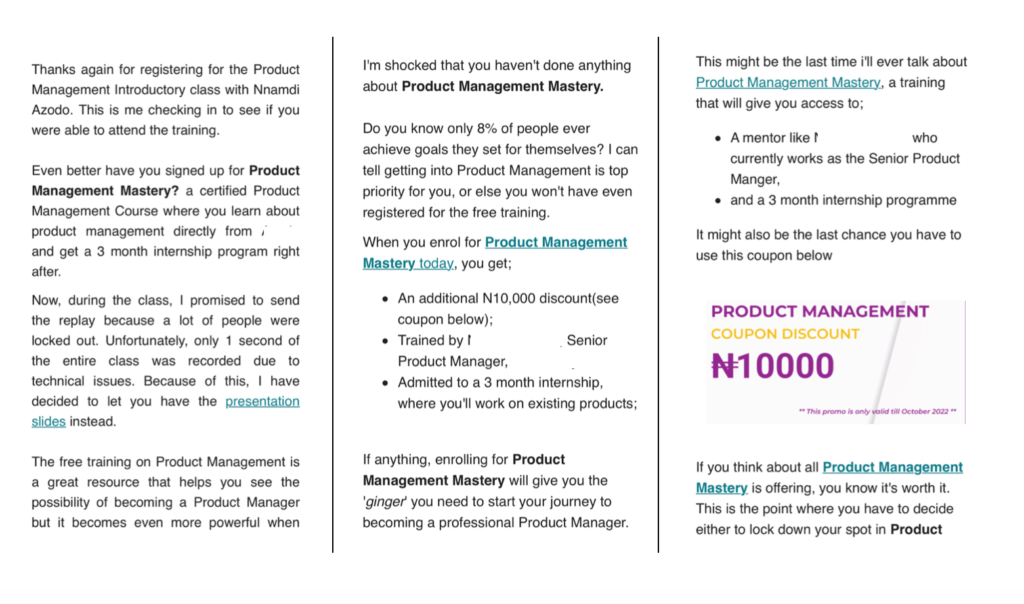
In October of 2022, after almost 10 months of testing, tweaking and redesigning different aspects of the sales process, I closed 7 sales from a single webinar. Read some of the replies from that campaign.
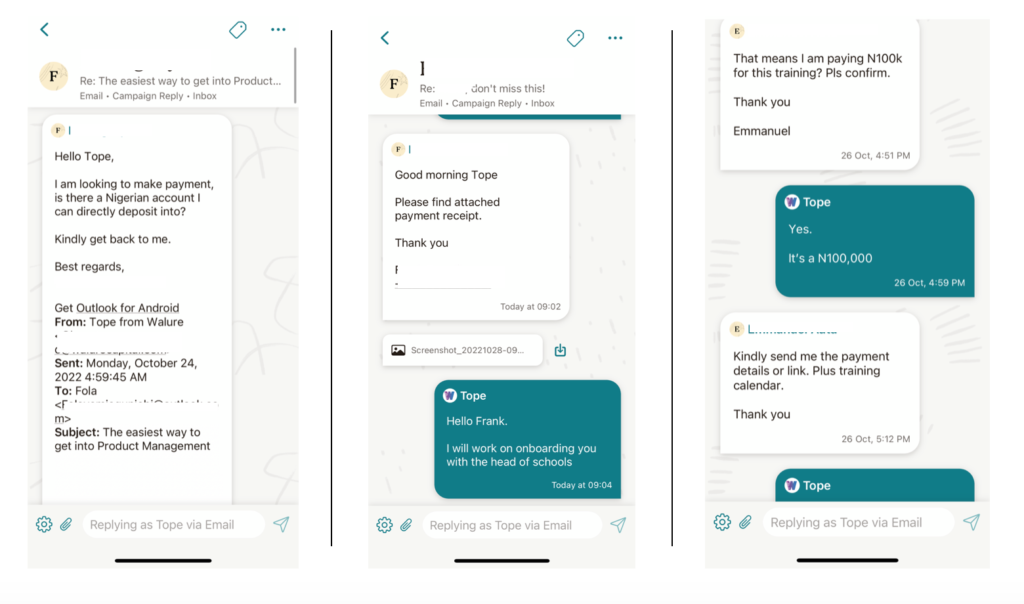
I knew I had found a model that worked. I asked them to scale the process but that never happened because I resigned.
Maybe that’s why they always say, we won’t always get a happy ending.
Subscribe to my blog for more stories on how I build and develop sales processes.

2 thoughts on “How to Use Webinars to Sell Online Courses”